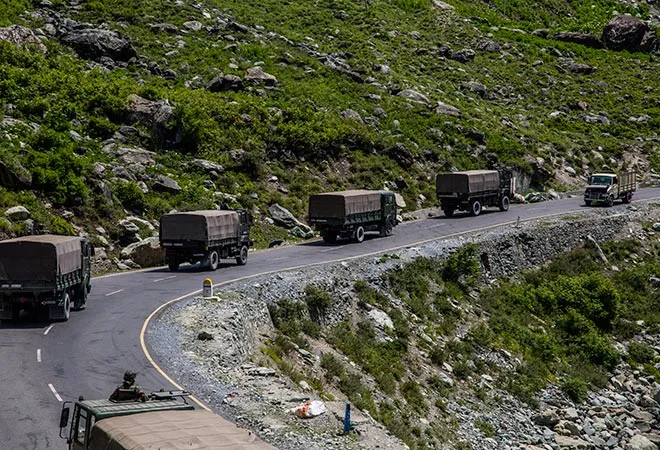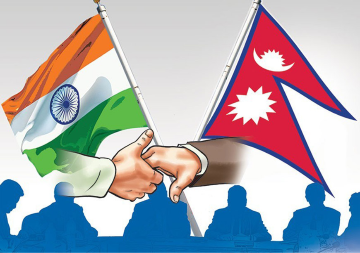
The 2020 India-China LAC crisis in Ladakh is arguably New Delhi’s “biggest strategic and security
challenge in decades.” 20 Indian soldiers were killed by PLA forces wielding iron rods,
clubs wrapped in barbed wire, and
sticks studded with nails on the night of 15 June. The Indian forces were overseeing a negotiated “de-escalation” in one section of the around
40-60 square km of territory which China has progressively occupied since at least May. This “de-escalation” turned out to be a ploy for the Chinese assault. If the Chinese occupation is allowed to stand, this will not only entail India publicly accepting Beijing’s land grab as a fait accompli, but also cut off Indian lifelines between its border posts. Moreover, it will grant the PLA a commanding position
overlooking the Indian Darbuk-Shyok-Daulat Beg Oldie road, critical for strategic purposes.
If the Chinese occupation is allowed to stand, this will not only entail India publicly accepting Beijing’s land grab as a fait accompli, but also cut off Indian lifelines between its border posts.
The first option available to Modi is to militarily force the Chinese forces back to the
1962 LAC claim line, which Beijing has historically de facto recognised in its patrol operations, albeit not de jure. The casualty rate of such an offensive would be very high, and raise escalation concerns, not least as China “
believes it needs to stand up to India whatever the cost.” However, based upon a recent
comprehensive estimate of major Indian and Chinese combat forces in their ground border areas, it is likely that India would eventually succeed in this effort, even with the new forces that China has moved closer to the border. India still retains the core advantage that more of its China-facing combat forces are located closer to border areas than vice versa. An additional — or simultaneous — option would be for India to open a new front by moving out of Arunachal Pradesh to seize Chinese territory in the eastern sector, strengthening New Delhi’s bargaining position in compelling Chinese withdrawal.
However, it appears more likely at present that Modi will seek to avoid further clashes against the Chinese occupying forces, and play for time in eventually securing a negotiated Chinese withdrawal later in the year. A global diplomatic campaign to damage China’s international image, including regularly briefing scores of foreign ambassadors on the nature of the incursion and of China’s brutality against Indian forces, could raise the political costs of Beijing’s actions. This could also include utilising India’s scheduled hosting of the 2021 BRICS summit to pressure China. Modi can publicly state that at present, he cannot see how he could invite China to attend if it is occupying Indian territory. India reportedly
used the China-hosted 2017 BRICS summit as similar leverage in ending the Doklam crisis, threatening China’s public embarrassment by India’s non-attendance without prior resolution of the crisis.
A global diplomatic campaign to damage China’s international image, including regularly briefing scores of foreign ambassadors on the nature of the incursion and of China’s brutality against Indian forces, could raise the political costs of Beijing’s actions.
Once this episode concludes, the magnitude of this crisis compels an official review as to how Chinese forces were able to find such advantages against India’s conventional force superiority. A component of this superiority, as discussed in the
force estimate, was the need for Chinese troops to be mobilised from areas further within its interior to prepare for such a border offensive. Compared to permanently stationing these forces close to the border areas — as India has selected — this longer Chinese geographic mobilisation trail would generate more signals and activities that Indian ISR would detect. This would enable New Delhi to counter-mobilise its forces toward border areas, and even rotate additional interior forces into the theater, further denying the incoming Chinese forces the potential of gaining the conventional edge and coercive leverage. Even if there were gaps in India’s close ISR attention on its border areas, it was likely that such significant Chinese military movements would be observed by the US, which would then alert and update India. This US ISR-sharing, after all,
occurred during the Doklam crisis.
Instead, it has become apparent that there have been grave failures somewhere (but more likely in multiple places) in the Indian intelligence chain, as it runs through from source to consumer. China achieved its current position in Ladakh through staging a military exercise as a
feint, sending forces to occupy the areas it now holds. Such heightened Chinese military activity close to border areas should have alerted Indian decisionmakers, who would order a stepping-up of Indian LAC patrols and general military readiness in these areas.
Compared to permanently stationing these forces close to the border areas — as India has selected — this longer Chinese geographic mobilisation trail would generate more signals and activities that Indian ISR would detect.
Multiple Indian intelligence agencies reportedly
provided warnings on concerning Chinese military activities as far back as February 2020. However, “when asked if there were any delays in acting on the intelligence alerts, officials said initial reports were not specific and the intent of Chinese deployment was not clear.” The more precise location of the likely Chinese incursion was only identified in April 2020. This means China was able to largely erase its mobilisation disadvantages compared to India, to the extent that the issuance of the precise intelligence warning gave so little time for Indian forces that they had to respond “by quickly rushing in troops from Leh.” Information regarding US intelligence-sharing on these Chinese movements is currently not publicly available. Even if New Delhi was in receipt of US intelligence reporting on these actions, it is still clear that India’s overall intelligence system — including the decisionmaker consumers — did not function effectively in the crucial period of early warning and counter-mobilisation.
An intelligence failure of this magnitude requires a
thorough official review of its structural causes and recommending reforms, similar to the Kargil Review Committee. If the government will not commission a public inquiry of its own accord, then it should be initiated by the Lok Sabha Standing Committee on Defence. The National Security Advisor (NSA), Ajit Doval, should be required to give evidence in this inquiry. This officeholder is charged with intelligence oversight and directly briefing the Prime Minister. Moreover, Doval’s long background in intelligence means he will have an additional level of insight regarding the core flaws in the system. Former NSAs, Deputy NSAs, and additional former senior intelligence officials should also be invited to participate and fully briefed accordingly by the government.
Even if New Delhi was in receipt of US intelligence reporting on these actions, it is still clear that India’s overall intelligence system — including the decisionmaker consumers — did not function effectively in the crucial period of early warning and counter-mobilisation.
Critics might suggest that this level of cross-party engagement and transparency is unlikely from Modi and the BJP. However, it is worth noting that Modi took the step to convene an all-party meeting on 19 June, to brief party leaders on the situation. Moreover, Modi’s recognition of the tenure-defining gravity of this situation was reflected in the public
correction of his initial claim at the June 19 meeting that there had been
no Chinese incursions. Had this statement been allowed to stand, this would imply that India had now accepted China’s claim to the Galwan River Valley as a fait accompli.
Moreover, the impacts of this crisis transcend the near-term political fortunes of Modi and the BJP. This episode, regardless of its outcome, could occasion a
transformative shift in India’s diplomacy toward China and the world. Given that this crisis appears set to
inform Indian foreign and defense policy for
decades to come, Modi must take the initiative to establish such an inquiry and act on its findings. This will ensure India’s intelligence systems and military forces are suitably robust and well-organised for this new era; a period which could last decades after Modi leaves office.
The views expressed above belong to the author(s). ORF research and analyses now available on Telegram! Click here to access our curated content — blogs, longforms and interviews.



 The 2020 India-China LAC crisis in Ladakh is arguably New Delhi’s “biggest strategic and security
The 2020 India-China LAC crisis in Ladakh is arguably New Delhi’s “biggest strategic and security  PREV
PREV


